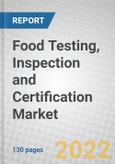This report provides market insights into the food testing, inspection and certification market, specifically focusing on the global markets. It provides an array of information, including market size, expected growth rates, market drivers and restraints, and other market trends and developments. This report analyzes the market trends of food safety testing with data from 2021, CAGR projections for the forecast period from 2022 to 2027 and an analysis of the top leading players in the food TIC market. BCC Research analyzed key categories and regions to determine the present and future food safety testing market status, as well as forecasted market growth from 2022 to 2027.
Report Includes
- 30 data tables and 18 additional tables
- An overview of the global market opportunities for food testing, inspection and certification along with the industry competitive landscape
- Analyses of the global and regional market trends, with historic market revenue data for 2021, estimates for 2022 and 2023, and projections of compound annual growth rates (CAGRs) through 2027
- Estimation of the actual market size and market forecast for food testing, inspection and certification, and corresponding market share analysis by technology, contaminant types, and region
- Discussion of current and future demand in the global food testing and inspection market, along with the industry value chain analysis, competitive environment, and technology updates
- Emphasis on the environmental, social, and governance (ESG) standards, players offering ESG services, and market outlook of ESG services for the food industry
- Analysis of the competitive landscape based on recent developments and segmental revenues
- Market share analysis of the key manufacturers in the food testing, inspection, and certification market, their business strategy analysis, product mapping, and operational integration
- Descriptive company profiles of the leading global players, including Hardy Diagnostics, Intertek group Plc, Promega Corp and R-Biopharm AG.
Table of Contents
Executive Summary
Testing, inspection and certification (TIC) are the most critical aspects of quality control across various industries, including the food industry. TIC is crucial for upholding the requirements for food safety and quality. The use of cutting-edge technology in the food business and the development of fresh, creative approaches (e.g., virtual inspections, and remote audits) to address the COVID-19 dilemma contributes to the TIC market’s growth. Organizations may increase productivity and reduce risk, as well as enhance the safety, quality and compliance of their goods and services using TIC services while still adhering to international standards.
Consumer awareness of food quality and safety issues has grown in recent years, mainly due to controversies involving recent food recalls and the pandemic’s increased concern for safety and cleanliness. This has facilitated the development of many food safety and quality standards in the public and commercial food sectors. A robust TIC system is required due to the rising instances of adulteration and substance mixing in food goods, such as oils and milk. Consumers are also becoming more knowledgeable regarding scams and risks. Testing, certification and inspection procedures ensure quality, safety and confidence.
The global food testing, inspecting and certification market is expanding, and it has significant growth potential during the forecast period. The growth of the food testing, inspection and certification market is driven primarily by the increasingincidence of foodborne diseases, advances in testing technology, globalization of food supply and strictinternational food safety regulations.
Increasing cases and stringent regulation of foodborne diseases due to various contaminants (e.g., pathogens, pesticides, genetically modified organisms (GMOs), toxins, food residues) are significant factors driving the food safety market. Rising consumer awareness of food safety and quality is also expected to drive the food safety testing market during the forecast period. Contaminants and chemicals can enter food at every stage of the value chain, from harvesting to manufacturing to the final consumer. Therefore, contamination can be a significant cause of food poisoning, requiring food quality control.
Strict regulations to enforce food safety guidelines in the U.S. and Canada have increased the demand for food safety testing services in the region. The passage of the U.S. Food Safety Modernization Act (FSMA) heralds a growth in the global market for food safety testing. Pathogen testing is widely used in the overall food testing market, as there is increasing pressure on food manufacturers to provide safe food and to implement food safety testing techniques. Salmonella, E. Escherichia coli, Listeria and Campylobacter are significant pathogens that cause food contamination and toxicity. The global increase in pathogen-induced foodborne diseases is driving the pathogen sector.
Companies Mentioned
- Als Ltd.
- Bio-Rad Laboratories Inc.
- Biocontrol Systems Inc.
- Biomedica Gruppe Osterreich
- Biomerieux S.A.
- Biotest AG
- Charm Sciences Inc.
- Covance Inc.
- Elisa Technologies Inc.
- Emsl Analytical Inc.
- Envirologix Inc.
- Eurofins Scientific Inc.
- Food Hygiene and Health Laboratory
- Genetic Id Na Inc.
- Global Food Safety Initiative
- Hardy Diagnostics
- Ieh Laboratories & Consulting Group
- Intertek Group plc
- Laboratory Corp. Of America Holdings
- Merieux Nutrisciences Corp.
- Micreos Food Safety
- Micro Identification Technologies, Inc.
- Microbac Laboratories Inc.
- Milliporesigma
- Neogen Corp.
- Promega Corp.
- R-Biopharm AG
- Randox Laboratories Ltd.
- Sgs Sa
- Tuv Sud Ag








